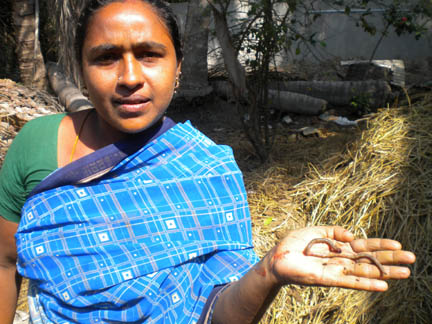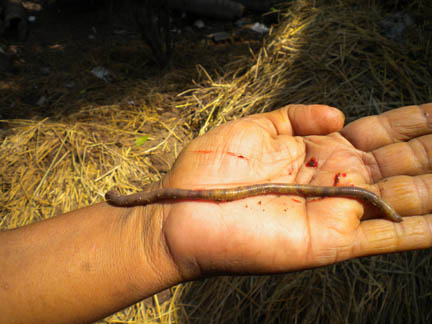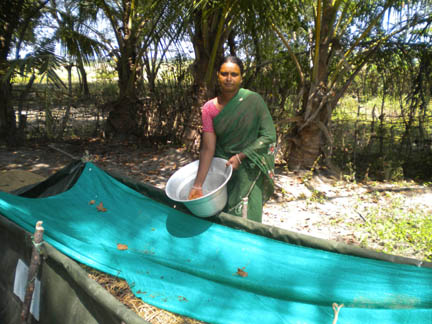Earthworms – Heroes of Organic Farming
-K. Amina Bibi
Earthworms are hermaphrodites. Each worm has both male and female organs. They are small tube like organisms who tirelessly work to turn the earth from lowest strata of earth to top. Worms tunnel deeply in the soil and bring subsoil closer to the surface
mixing it with the topsoil. This makes the formation of multitude of linear tunnels minute in diameter but deeper below the subsurface. These tunnels last long even after the worms are dead. These tunnels facilitate infiltration of water into subsurface, reduce
runoff, help in harvesting rainwater. Such stored moisture is slowly released to crop at summer season. In this process of tunneling it also maintains the soil structure and enables the processes of aeration. This act makes EARTHWORM as a Real Farmer who toils
day long tilling the fields. In the fields of organic cultivation we could see the reserve moisture throughout the year. The latent hard work of a large number of worms helps the crop survive when the other areas are parched.
.jpg)
Earthworms live on what we call WASTE. Yes, they feed on the vegetable wastes we throw; leaves shed from trees and any form of organic matter available in soil, and living organisms such as nematodes, protozoans, rotifers, bacteria, fungi which are harmful
to plant growth. Their intake per day is one third of their body weight.

The organic matter the earthworms consume gets digested in their bodies and gets excreted in the form of casts, a type of soil aggregate rich in nutrition. Thus Earthworms facilitate improving soil fertility and deposits on the surface. Their role gains
significance because they convert larger organic matter into simple accessible form. This is also the Nutrition cycle. Slime, a secretion of earthworms, contains nitrogen. Nitrogen is an important nutrient for plants. The sticky slime helps to hold clusters
of soil particles together in formations called aggregates. These have greater role in porosity which helps in aeration and physical property of soil. The micro-tunnels provide good root growth as they are lined with readily available nutrients and make it
easier for roots to penetrate deep into the soil.

Three months back there was a fertilizer scarcity in our place as well as throughout Tamil Nadu State. Farmers were ready to pay twice or thrice to purchase a bag of UREA and DAP. The MRP cost of it was around Rs. 2000 (both). They were running between
pillars in search of availability of fertilizers. Some innovative organic growers were at peace, not worrying about the fertilizer scarcity.

They just scooped the vermicompost produced in their backyard and just spread (broadcasted) in the fields. Compared to the fields with chemical fertilizers, organic fields were outstanding and the yield comparatively higher. Vermicompost supplied many
minerals needed for the complete crop growth. The pest load was very less due to available farmers’ friends (natural predators and parasites) which took care of the pest control. The farmer had no need to go for any pesticide spray as the pests were below
Economic Threshold Level. These were the visible advantages. Beyond this there were more advantages like the vegetables had longer shelf life, tasted better, and many more…
In an organic field, earthworm multiplication becomes natural and nutrition cycle is in full swing and the field is not limited with any nutrition. The web of life is perfect in Organic Farming and Earthworm has a great role to play in this; be it cycling
of nutrients, micro-flora and fauna population. It also becomes a prey to birds and it goes on. The load of earthworm in a field is directly proportionate to the nature friendly living (ORGANIC).
Due to the chemical farming methods, the earth worm population is greatly reduced. The trend is to turn back to nature and regain the earthworm population farmers are rearing in the valuable Vermicompost pits, either with permanent structures or temporary
structures made of Silpauline sheets. When vermicompost (the casts collected from the pit), a rich source of nutrition, is applied to fields, the crop stand is very good due to supply of multiple nutrients. Often the field itself becomes a vermicompost unit
as the applied vermicompost contains inoculums of cocoons, from which earthworms’ population increases. Sometimes segments of earthworm reach the field with vermicompost as earthworms have the ability to regenerate lost segments, the population increases.
After prolonged use of vermicompost the lost microbial load is regained and so is the quality of food we get from fields.
(K. Amina Bibi is a Post Graduate in Agriculture with specialization in Plant Breeding and Genetics. She is currently working as Agriculture Officer in Karaikal, Department of Agriculture, Government of Puducherry)